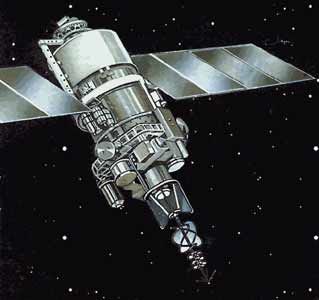
Home - Search - Browse - Alphabetic Index: 0- 1- 2- 3- 4- 5- 6- 7- 8- 9
A- B- C- D- E- F- G- H- I- J- K- L- M- N- O- P- Q- R- S- T- U- V- W- X- Y- Z
Meteor-3M
 Meteor-3M Credit: NPO PM |
AKA: 17F45M. Status: Operational 2001. First Launch: 2001-12-10. Last Launch: 2001-12-10. Number: 1 . Gross mass: 2,500 kg (5,500 lb). Height: 2.20 m (7.20 ft).
Use of the Zenit launch vehicle allowed the overall mass of the Meteor-3M spacecraft to be increased to 2,500 kg, including a larger payload of up to 900 kg. In addition, the average daily power available nearly doubled to 1 kW, and the spacecraft stabilization accuracy was improved by an order of magnitude. Pointing accuracy was improved. Satellite design lifetime increased to three years.
The store and forward transmission mode was converted from the earlier 466.5 MHz analogue to 1.69-1.71 GHz digital. The 1.4 diameter, 2.2 m long spacecraft bus carried a payload truss (as on Meteor 3) with dimensions 1.800 mm by 1.600 mm by 270 mm. High-temperature ammonia thrusters (0.147 N) were used for orbital adjustment of the basic 900 km 950 km orbit. Originally slated for a 900 km x 950 km orbit with an inclination of 82.5 degrees, Meteor 3M was instead inserted into a 1000 km altitude sun-synchronous orbit.
In 1994 NASA was negotiating with the Russian Space Agency to carry the SAGE III (Stratospheric and Aerosols and Gas Experiment) instrument on a 1998 Meteor. This did not fly until the first Meteor-3M flight in 2001.
More at: Meteor-3M.
Family: Earth, Earth weathersat, Medium earth orbit. Country: Russia. Launch Vehicles: Zenit-2. Launch Sites: Baikonur, Baikonur LC45/1. Agency: VNIIEM. Bibliography: 119, 2, 296, 445, 552, 554, 12827.
 | Meteor-3M Credit: Manufacturer Image |
2001 December 10 - . 17:18 GMT - . Launch Site: Baikonur. Launch Complex: Baikonur LC45/1. LV Family: Zenit. Launch Vehicle: Zenit-2.
- Meteor-3M - .
Payload: Meteor 3M-N1. Mass: 2,500 kg (5,500 lb). Nation: Russia.
Agency: RAKA.
Manufacturer: VNIIEM.
Class: Earth.
Type: Weather satellite. Spacecraft Bus: Meteor.
Spacecraft: Meteor-3M.
USAF Sat Cat: 27001 . COSPAR: 2001-056A. Apogee: 1,014 km (630 mi). Perigee: 994 km (617 mi). Inclination: 99.20 deg. Period: 105.20 min.
Meteorology satellite. Launch postponed from late 2000, then delayed from November 30. The Meteor-3M weather satellite carried visible and IR sensors as well as NASA's SAGE III instrument which studied aerosols and the ozone layer. This was the first launched of a modernised version of the spacecraft. Launch be Zenit launch vehicle from Baikonur rather than Tsyklon 3 from Plesetsk allowed the spacecraft to be 350 kg heavier, carrying additional sensors and various piggy-back payloads.
Back to top of page
Home - Search - Browse - Alphabetic Index: 0- 1- 2- 3- 4- 5- 6- 7- 8- 9
A- B- C- D- E- F- G- H- I- J- K- L- M- N- O- P- Q- R- S- T- U- V- W- X- Y- Z
© 1997-2019 Mark Wade - Contact
© / Conditions for Use